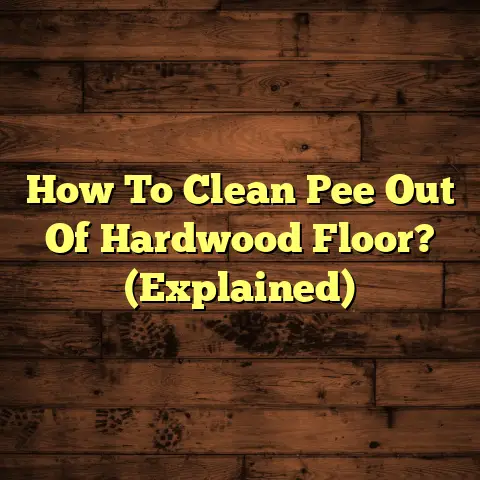Prefinished Hardwood: Cheaper? (3 Costly Secrets)
When it comes to flooring, what seems cheap often hides the most expensive truths.
That’s a bold statement, I know.
But after years in the flooring business, I’ve seen it happen time and time again, especially with prefinished hardwood.
It’s tempting, I get it. The promise of quick installation and lower upfront costs is attractive.
But before you jump on the prefinished bandwagon, let’s pull back the curtain and expose some costly secrets.
Section 1: Understanding Prefinished Hardwood Flooring
So, what exactly is prefinished hardwood?
Simply put, it’s hardwood flooring that has already been sanded, stained, and sealed at the factory.
This is different from unfinished hardwood, which arrives at your doorstep raw and requires on-site sanding, staining, and finishing.
Think of it like buying a car: prefinished is like getting a fully loaded model off the lot, ready to drive.
Unfinished is like buying a kit car – more work, but potentially more customized to your liking.
Manufacturing Magic
The manufacturing process of prefinished hardwood is pretty fascinating.
The raw wood planks are fed through a series of machines that:
- Sand them smooth
- Apply multiple coats of stain
- Finally, cure them with UV light or other methods to create a durable finish.
The type of finish used is crucial. You’ll often see options like:
- Polyurethane: A tough, water-resistant finish, but can sometimes look a bit “plasticky.”
- Aluminum Oxide: An incredibly durable finish, often found on high-traffic floors.
- Oil-Based Finishes: These penetrate the wood for a natural look and feel, but require more maintenance.
Wood Species and Your Wallet
Just like with unfinished hardwood, prefinished options come in a wide range of wood species, each with its own price tag.
Some popular choices include:
- Oak: A classic and affordable choice, known for its durability.
- Maple: A harder wood with a lighter color, but can be more prone to showing scratches.
- Hickory: A very hard and durable wood with a rustic look.
- Exotic Woods (Brazilian Cherry, Ipe, etc.): Beautiful and unique, but often the most expensive and may have sustainability concerns.
The species you choose will significantly impact the overall cost of your project.
Section 2: The Cost Comparisons
Alright, let’s get down to brass tacks: how much does all this really cost?
It’s tempting to look at the sticker price of prefinished vs. unfinished, but that’s just the tip of the iceberg.
Upfront Costs: Prefinished vs. Unfinished
On average, prefinished hardwood flooring can be cheaper to purchase than unfinished.
According to recent estimates, prefinished hardwood ranges from \$3 to \$12 per square foot, while unfinished can range from \$5 to \$15 per square foot. (Source: HomeAdvisor)
However, that price difference can quickly evaporate when you factor in installation.
Installation: Where the Savings Can Vanish
Prefinished flooring is often marketed as a DIY-friendly option, which can save you money on labor costs.
And it’s true, the installation process is generally faster and less messy than unfinished.
But don’t be fooled!
Proper installation is crucial for the longevity and performance of any hardwood floor.
If you’re not experienced, you could end up with:
- Gaps between planks
- Uneven surfaces
- Squeaky floors
These issues can lead to costly repairs down the line, wiping out any initial savings.
Plus, you’ll need to factor in the cost of tools and materials, such as:
- Underlayment
- Nail gun or flooring stapler
- Moisture meter
Long-Term Costs: The Real Test
The true cost of flooring isn’t just about the initial price tag, it’s about how it holds up over time.
Prefinished floors often have a thinner wear layer than unfinished floors that are sanded and finished on-site.
This means they may be more susceptible to scratches and wear, requiring refinishing or replacement sooner than an unfinished floor.
Refinishing a hardwood floor can cost anywhere from \$3 to \$8 per square foot, depending on the extent of the damage and the type of finish used.
So, while you might save money upfront with prefinished, you could end up paying more in the long run if you have to refinish or replace it sooner.
Section 3: The Three Costly Secrets of Prefinished Hardwood Flooring
Okay, now for the juicy part: the secrets that flooring companies don’t want you to know.
Secret 1: The Hidden Costs of Installation
I touched on this earlier, but it’s worth diving deeper.
The biggest hidden cost of prefinished flooring is improper installation.
Subfloor Sabotage
A level and stable subfloor is essential for any successful flooring installation.
If your subfloor is uneven or damaged, you’ll need to repair or replace it before installing your new floor.
This can add significant time and expense to your project.
Acclimation Anxiety
Hardwood flooring is a natural product that expands and contracts with changes in humidity.
Before you install prefinished flooring, it needs to acclimate to the environment in your home.
This means leaving the boxes of flooring in the room where they will be installed for several days, or even weeks.
If you skip this step, you could end up with gaps or buckling in your floor.
The DIY Disaster
While prefinished flooring is often marketed as a DIY-friendly option, it’s not as easy as it looks.
Even experienced DIYers can make mistakes that can lead to costly repairs.
Unless you’re confident in your skills, it’s best to hire a professional installer.
Secret 2: The Longevity and Durability Question
How long will your prefinished floor really last?
That depends on a number of factors, including:
- The type of wood
- The thickness of the wear layer
- The quality of the finish
- How well you maintain it
Wear and Tear Tales
As I mentioned earlier, prefinished floors often have a thinner wear layer than unfinished floors.
This means they may be more susceptible to scratches, dents, and wear.
If you have pets or kids, this is especially important to consider.
Environmental Enemies
Environmental factors can also impact the durability of your prefinished floor.
Excessive moisture can cause the wood to warp or buckle.
Sunlight can fade the finish over time.
And extreme temperature changes can cause the wood to expand and contract, leading to gaps or cracks.
Replacement Realities
Even with proper care, prefinished floors will eventually need to be refinished or replaced.
The lifespan of a prefinished floor can range from 10 to 30 years, depending on the factors I mentioned above.
When it comes time to replace your floor, you’ll need to factor in the cost of removing the old flooring and installing the new flooring.
Secret 3: The Environmental and Resale Value Impact
Choosing flooring is about more than just aesthetics and cost, it’s also about the environment and your home’s value.
Environmental Ethics
The sourcing and manufacturing of prefinished hardwood can have environmental implications.
Some prefinished floors are made from sustainably harvested wood, while others are not.
Some finishes contain volatile organic compounds (VOCs), which can be harmful to your health and the environment.
When choosing prefinished flooring, look for products that are certified by organizations like the Forest Stewardship Council (FSC) and have low VOC emissions.
Resale Value Realities
The type of flooring you choose can also impact the resale value of your home.
Hardwood floors are generally considered a desirable feature by homebuyers.
However, the quality and condition of the flooring can make a big difference.
A poorly installed or damaged prefinished floor can actually detract from your home’s value.
A well-maintained, high-quality hardwood floor can increase your home’s value and make it more attractive to buyers.
Section 4: Real-Life Case Studies
Let’s take a look at some real-life examples of homeowners and businesses that chose prefinished hardwood flooring.
Case Study 1: The DIY Disaster
John and Mary decided to install prefinished hardwood flooring in their living room to save money.
They watched a few YouTube videos and thought they were ready to tackle the project.
However, they didn’t properly prepare the subfloor, and they didn’t allow the flooring to acclimate properly.
As a result, their floor developed gaps and squeaks within a few months.
They ended up having to hire a professional to repair the floor, costing them more than if they had hired a professional in the first place.
Case Study 2: The Long-Term Winner
Sarah chose a high-quality prefinished hardwood floor for her kitchen.
She hired a professional installer and took good care of the floor.
After 20 years, the floor still looked great and added value to her home when she decided to sell.
Testimonial from a Flooring Professional:
“I’ve seen a lot of homeowners choose prefinished flooring because they think it’s cheaper and easier to install,” says Tom, a flooring contractor with 15 years of experience.
“But I’ve also seen a lot of them end up regretting it.
If you’re not careful, you can end up with a floor that looks cheap and doesn’t last very long.”
Section 5: Conclusion
So, is prefinished hardwood flooring really cheaper?
The answer, as you’ve probably guessed, is: it depends.
While the initial cost of prefinished flooring may be lower than unfinished flooring, there are several hidden costs and potential pitfalls to consider.
Let’s recap those costly secrets:
- The Hidden Costs of Installation: Improper installation can lead to costly repairs down the line.
- The Longevity and Durability Question: Prefinished floors may not last as long as unfinished floors.
- The Environmental and Resale Value Impact: The sourcing and manufacturing of prefinished flooring can have environmental implications, and the quality of the flooring can impact your home’s resale value.
Remember that bold statement I made at the beginning of this article?
“When it comes to flooring, what seems cheap often hides the most expensive truths.”
I hope I’ve shed some light on those truths and helped you make a more informed decision about prefinished hardwood flooring.
Before you make a final decision, I encourage you to:
- Get quotes from multiple installers.
- Research the different types of prefinished flooring.
- Consider your lifestyle and budget.
Choosing the right flooring is a big decision, so take your time and do your homework.
Your feet (and your wallet) will thank you for it!





